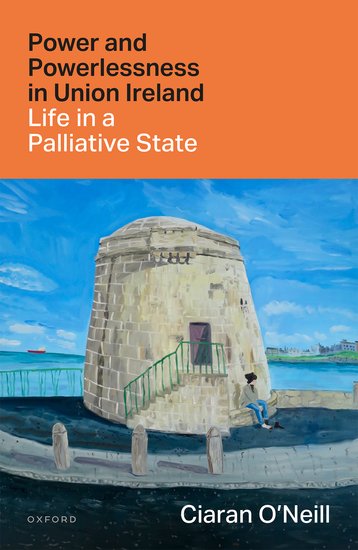CIARAN O’NEILL
Oxford University Press
£99
ISBN 9780192855428
Peter Gray is Professor of Modern Irish History at Queen’s University, Belfast.
This is, as the author asserts, a book of ideas. At times insightful, at others provocative, it explores the nature(s) of power and its absence in the era of ‘Union Ireland’, from the end of the Irish parliament in 1801 to the formation of the independent state in 1922. Rather than offering a conventional narrative or structural gazetteer of the state in Ireland department by department (in the manner of R.B. McDowell’s 1964 classic The Irish administration 1801–1914), O’Neill presents the reader with a series of interlinked vignettes to illustrate the workings of power, resistance to it and lack of it. These are informed by deep readings into social, post-colonial and feminist theory. Some will find this level of theorisation illuminating, others perhaps more frustrating. While the focus of the book remains on Ireland and, inevitably, its relations with the epicentre of colonial power in London, the author’s gaze extends into comparative dimensions (especially the multinational Habsburg empire) and the expanding Irish diaspora of the nineteenth century. Connecting all is the pervasive concept of the ‘coloniality of power’, rooted deep in the longue durée geopolitical relations between the two islands but also manifested throughout social relations within Ireland itself, the development of its civil society and the colonial attitudes in turn adopted and projected by both Irish élites and the masses of settlers who made up Ireland overseas.
A central argument is that, for all its colonial subordination, the ‘half-formed and truncated’ Irish state deserves attention in its own right rather than being simply written off as a British ‘garrison state’ in Ireland. Even if always preoccupied with security and informed by deeply prejudicial stereotypes of Irish ‘ungovernability’, the state evolved into a hybrid form, with significant sections of Irish society becoming ‘complicit’ in its operations and attempts (ultimately unsuccessful) to acquire legitimacy in the eyes of the governed. A study of power in this period must therefore look not only at direct or cloaked forms of coercion mirrored by the ‘empowerment’ of subjects embodying various strategies of resistance but also at the accommodations with the state attempted by much of the Catholic middle class (whom O’Neill has already done much to bring into the historical spotlight), often at the expense of the traditional landed ruling élite.
The book eschews the grand narratives of both nationalist ‘charismatic history’ and the high politics of official policy-making and plays down the constitutional discontinuities of 1801 and 1922 to focus on the less formal dynamics of power. Of course, in a book of this sort it is impossible to pass entirely over the formal structures and personnel of the state, and early chapters sketch out the shifting balance of power in local government, the ‘deep state’ of Dublin Castle and its offshoot at the Irish Office in London. Perhaps inevitably a few errors have crept in here, although they actually tend to strengthen rather than undermine O’Neill’s case about the state’s hybridity. Rather than the Irish undersecretaries being ‘typically English or Scottish’, the office was held by ten Irish-born men in the Union era, covering some 57% of its duration (four of these, in office for nearly a quarter of the period, were Irish Catholics). Four rather than three of the lords lieutenant were Irish by birth or upbringing (although Lord Naas was not one of them). There are some recent studies of Catholic power brokers such as Thomas Redington and Anthony MacDonnell, but we still lack one of T.H. Burke, who was at the heart of the Castle administration for thirteen years before his assassination in Phoenix Park in 1882.
The subtitle of the book labels the period as that of the ‘palliative state’, an idea that O’Neill deploys to suggest progressive resignation to the state’s failure to persuade the governed of its legitimacy, consciousness of its precarity and the adoption of policies intended to sooth rather than cure disaffection, as well as to the state of being of those trapped in this ‘holding pattern’. This metaphor has its attractions, although arguably it fits unevenly with the chronology of the ‘Union State’, and excluding governing strategy and mobilised mass resistance from the equation makes it difficult to assess its validity. Early chapters in the book explore aspects of the creation (or perhaps further development) of a ‘security state’ in Ireland, emblematised by the Martello tower chosen for the cover illustration. Further chapters explore the development of both state surveillance and its carceral infrastructure in a suitably Foucauldian manner. The middle decades of the century might better be seen as an era of a radically integrative state strategy, pursuing accommodation of Catholics at the expense of the landed élite, economic integration with Great Britain and application of modes of ‘scientific’ administration (as opposed to ‘Irish facts’) that might make Ireland truly British. The first era of accommodationism ended catastrophically with the failed social engineering of the Great Famine, but optimism about transforming Ireland revived with Gladstonianism in the 1860s–80s. Arguably the ‘palliative state’ model works best for the later decades of the Union than for these episodes.
The author describes his book as ‘exploratory’ and it will no doubt stimulate heated debate—not least over its final provocations that the Irish revolution changed little in the nature of state power, and that the post-Troubles North might also be read as a ‘palliative state’. It is essential reading for those interested in the state and the nature of power in the Union period.

